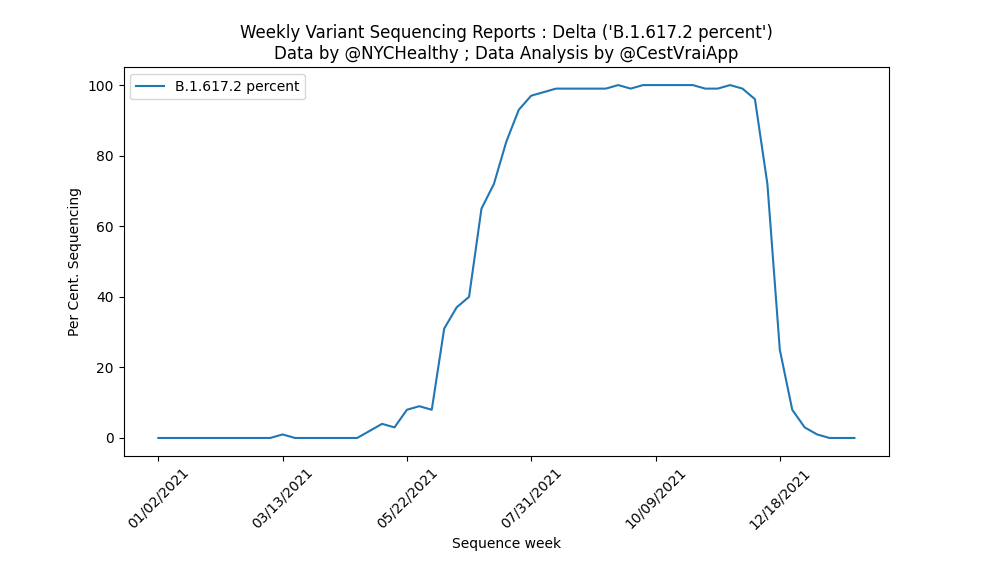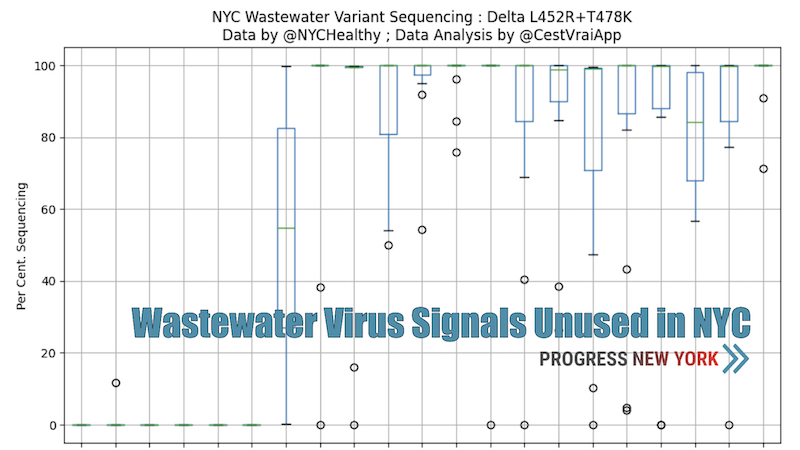Former Mayor Bill de Blasio waited to call for a mask mandate in response to the Delta variant outbreak, weeks after wastewater sequencing indicated worrying signals.
By LOUIS FLORES
Updated 12 Feb 2022 12:35 Critics of the Government’s flagging response to the Coronavirus pandemic have long pointed to unused tools in its metaphorical toolbox to keep the public vigilant about the dangers of emerging variants. One of those chief tools is wastewater sample testing to monitor for signals of outbreaks. Before the end of March 2020, scientists in The Netherlands were already drawing attention to their ability to “monitor the circulation of the virus” in wastewater, according to a study that became the subject of a report published by Forbes.
But in New York City, wastewater surveillance data has not been published on the City’s COVID-19 data tracking site, and some advocates for greater Government transparency have had to confront Government officials online in order to press for the release of the data.
After Progress New York filed an open records request, seeking four categories of records about the City’s wastewater surveillance programme, the City’s health ministry released one spreadsheet of incomplete data. According to separate information obtained by Progress New York, the City of New York has pledged surveillance data from various wastewater treatment plants to different groups of academic researchers. In part because of the exclusivity of those arrangements, the public signaling function of wastewater surveillance data goes unused in New York City. Indeed, a COVID-19 wastewater research study was recently published by scientists, marking one of the rare occasions when conclusions about New York City wastewater surveillance data, although delayed and also limited, has been released.
Over/under on next variant explosion?
— rbe (@perdidostschool) February 9, 2022

The City’s FOIL Release of wastewater data was deliberately incomplete, revealing that the City may be depriving the public of Coronavirus pandemic infection signals.
Data analysis of the FOIL Response produced by the New York City Department of Health and Mental Hygiene was so incomplete that it showed skewed results for the visual distribution of the prevalence of the Delta variant in wastewater samples for the weeks of 7 June 2021, 14 June 2021, and 28 June 2021, for example, a period of time when some readings ranged from zero per cent. to 99.9 per cent. Because wastewater surveillance is capable of detecting COVID-19 cases before individuals become symptomatic, wastewater surveillance measurements will appear higher than sequencing reports for samples drawn from COVID-19 tests.
Although the dates for which the City publishes its weekly variant sequencing reports from tests do not correspond with the wastewater surveillance reports, data publicly posted as of Thursday for the relevant time period showed that the Delta variant was being detected at a narrower band of levels amongst individuals, from 31 per cent. as at 12 June 2021, to 37 per cent. at 19 June 2021, and to 40 per cent. at 26 June 2021.

The City’s weekly variant sequencing reports were initially not accurate, and City Hall was not sharing alarming wastewater sequencing data with the public.
During this time, the City’s weekly variant sequencing reports were raising questions amongst critics of the Government’s lax pandemic response. A report published by Progress New York on 20 June 2021 showed that the City’s reported prevalence of the Delta variant was even lower than the current data suggests. At that time then, the City estimated the Delta variant at only a 6 per cent. prevalence, which, as Progress New York noted, represented a deviation from an estimate of a 31 per cent. prevalence, according to a data model constructed by the Financial Times.
As the Delta variant began to circulate in New York City, the City’s weekly variant sequencing reports were also delayed, transitioned from .PDF format to hosting on Github, and restated in part. In the time leading up to that period, the number of samples upon which the weekly variant sequencing reports were being based began to fall, and the number of samples breeched a minimum number estimated to be required to meet statistical confidence levels, according to a data model constructed by Progress New York.
As recently as seven days ago, the U.S. Centers for Disease Control and Prevention was still talking up the use of wastewater surveillance as an “important opportunity for monitoring the spread of infection.” However, since the prior administration of Mayor Bill de Blasio (WFP-New York City), the Government has indicated that it would not close or restrict the economy in response to variant outbreaks. The limited release of wastewater surveillance data appears to confirm that policy stance, since the de Blasio administration stalled the issuance of a health advisory for a renewed public use of masks from mid-July to late-July, by which time the wastewater sequencing had long signaled that the highly-contagious Delta variant had become dominant. The Government apparently decided to completely neglect its obligation to voluntarily comply with transparency laws by refusing to publicly release the wastewater signals, much less to dutifully use the tool of wastewater surveillance to inform responsible public health policy during the pandemic. Since minor infections of COVID-19 can lead to heart disease, the consequences of the Government’s policy of mass infection will continue to lead to deaths and bodily injuries.
The wastewater surveillance spreadsheet produced by the City began to show an initial detection of the Omicron variant as early as November 2021, but not enough data was released about the Omicron variant to draw conclusions from data analysis. The City’s health ministry never responded to objections raised by Progress New York about the limited production of responsive records. As a result, Progress New York has filed an appeal of the City’s constructive denial of the open records request.
⚠️SUB-VARIANT SURGING—Omicron 2.0 is rising—the #BA2 sublineage of #Omicron has *tripled* in one week, dislodging the old Omicron from total dominance—BA2 now at 3.6% and climbing fast. Expect to be dominant by March. Omicron reinfections are possible. ? https://t.co/amAjDWuN6Z pic.twitter.com/dU8ewDhii1
— Eric Feigl-Ding (@DrEricDing) February 9, 2022
Source Document
- 20220126 NYCDOHMH – FOIL Response 1 (Automatic Download) [Archive.org]
Recommended Reading
- Newly released New York City wastewater SARS-CoV-2 sequencing records confirmed early, never before admitted detection of the Omicron variant [Progress New York]
- After New York City missed the Omicron outbreak, the Government’s lockstep acts to deny the public release of pandemic data become clear [Progress New York]

